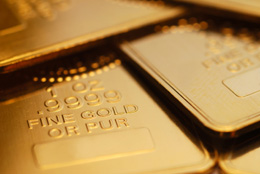 Gold and silver prices, as measured by the London PM Fix Price, were largely unchanged on the week. Gold slipped by $18 per ounce while silver declined modestly by $.05
Gold and silver prices, as measured by the London PM Fix Price, were largely unchanged on the week. Gold slipped by $18 per ounce while silver declined modestly by $.05
Gold has rallied almost $100 per ounce since late January but has failed to decisively break out to new all time highs. Silver, the standout performer in the precious metals sector has rallied furiously since late January, gaining $10 per ounce for an increase of 36%.
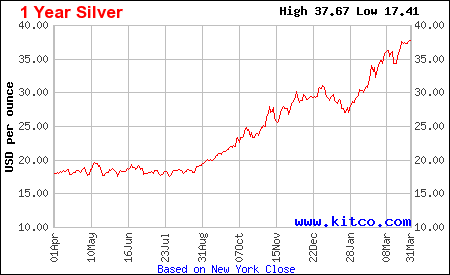
SILVER - COURTESY KITCOSILVER.COM
Despite the current attempt by Congress to implement very modest budget reductions, fewer and fewer people seem to have faith in the long term value of the dollar. The value of gold has not gone up for 10 years straight by accident – it is the result massive increases in debt and the looming threat of paper currency depreciation as governments resort to the printing presses to avoid defaulting. (See Why There Is No Upside Limit for Gold and Silver). Recent comments by two prominent individuals reinforce the view that the potential fallout from the debt crisis will be severe.
Bill Gross of Pimco, the world’s largest bond investor, writes in his April 2011 Investment Outlook, “Unless entitlements are substantially reformed, I am confident that this country will default on its debt; not in conventional ways, but by picking the pocket of savers via a combination of less observable, yet historically verifiable policies – inflation, currency devaluation and low to negative real interest rates”.
John Lipsky of the International Monetary Fund warned that the level of debt by developed nations is unsustainable, having reached levels last witnessed after the end of World War II. According to Mr. Lipsky, “The fiscal fallout of the recent crisis must be addressed before it begins to impede the recovery and create new risks. The central challenge is to avert a potential future fiscal crisis, while at the same time creating jobs and supporting social cohesion”.
The reality of a democracy is that we elect those who promise to provide us with the most benefits and entitlements. Under these constraints, the temptation by elected officials to use printed money to meet promises that cannot be kept is irresistible. Yes, the promises will be kept but they will be paid for in dollars that have little purchasing value.
| Precious Metals Prices | ||
| Fri PM Fix | Since Last Recap | |
| Gold | $1,418.00 | -18.00 (-1.25%) |
| Silver | $37.63 | -0.05 (-0.13%) |
| Platinum | $1,773.00 | +21.00 (+1.20%) |
| Palladium | $772.00 | +18.00 (+2.39%) |
Platinum and palladium both gained on the week, continuing a rebound from recent sell off lows reached during the height of the panic related to the Japanese earthquake. Since mid March, platinum has gained $73 per ounce while palladium has gained $60 per ounce. In late February palladium was at the $860 level while platinum traded in the $1850 range.

 As measured by the London PM Fix price, gold and silver prices gained on the week after declining approximately 1% each in the previous week. Gold gained $8.50 per ounce on the week to $1,420.00. Silver was the stand out gainer on the week with a 3% or $1.05 per ounce gain. As the situation in Japan and Libya stabilized somewhat, the recent panic selling in financial markets subsided as bargain hunters moved in, although in late trading, stocks gave up much of their gains. Gold and silver also pulled back slightly in New York trading with gold at $1417.80 and silver at $35.10.
As measured by the London PM Fix price, gold and silver prices gained on the week after declining approximately 1% each in the previous week. Gold gained $8.50 per ounce on the week to $1,420.00. Silver was the stand out gainer on the week with a 3% or $1.05 per ounce gain. As the situation in Japan and Libya stabilized somewhat, the recent panic selling in financial markets subsided as bargain hunters moved in, although in late trading, stocks gave up much of their gains. Gold and silver also pulled back slightly in New York trading with gold at $1417.80 and silver at $35.10.
 Gold and silver prices declined slightly on the week, as measured by the closing London PM Fix prices. Gold finished the week at $1,411.50 for a loss of $15.50 while silver declined fractionally by 33 cents to close at $34.10. However, as markets assessed the impact of a slowing world economy, higher inflation, higher oil prices and the massive earthquake in Japan, prices for gold and silver saw significant price improvement in late Friday New York trading. Gold moved up $9.20 to $1,421.30, while the silver price rose $.60 to $35.90.
Gold and silver prices declined slightly on the week, as measured by the closing London PM Fix prices. Gold finished the week at $1,411.50 for a loss of $15.50 while silver declined fractionally by 33 cents to close at $34.10. However, as markets assessed the impact of a slowing world economy, higher inflation, higher oil prices and the massive earthquake in Japan, prices for gold and silver saw significant price improvement in late Friday New York trading. Gold moved up $9.20 to $1,421.30, while the silver price rose $.60 to $35.90.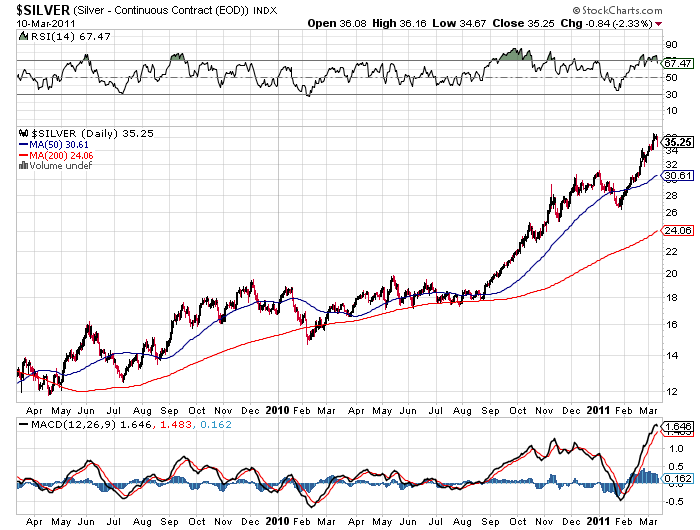
 The Week in Precious Metals
The Week in Precious Metals
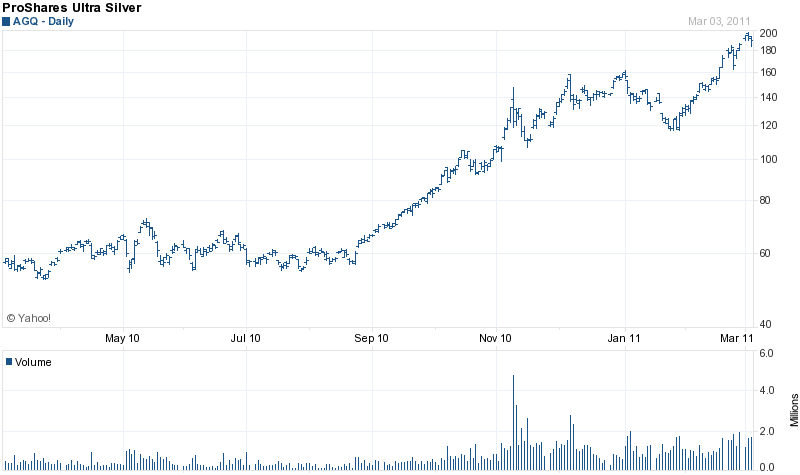
 As turmoil reigned in the Middle East and worries mounted over the reduction of oil supplies, gold and silver proved their safe haven status as both moved higher in price.
As turmoil reigned in the Middle East and worries mounted over the reduction of oil supplies, gold and silver proved their safe haven status as both moved higher in price.
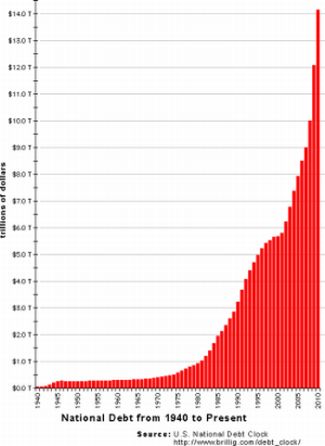
 Gold demand increased strongly across all sectors during 2010, as the supply of gold barely increased.
Gold demand increased strongly across all sectors during 2010, as the supply of gold barely increased.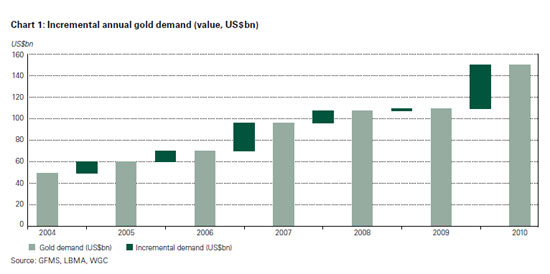
 Another Precious Week
Another Precious Week Investors and analysts alike are looking at the record prices of gold last year and trying to predict the future. Last year the price of gold rose by more than 27%, contributing to an increase of more than 400% over the past decade.
Investors and analysts alike are looking at the record prices of gold last year and trying to predict the future. Last year the price of gold rose by more than 27%, contributing to an increase of more than 400% over the past decade.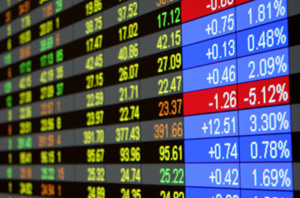 Precious metals delivered another year of strong performance, with double digit percentage gains for gold, silver, platinum, and palladium.
Precious metals delivered another year of strong performance, with double digit percentage gains for gold, silver, platinum, and palladium.